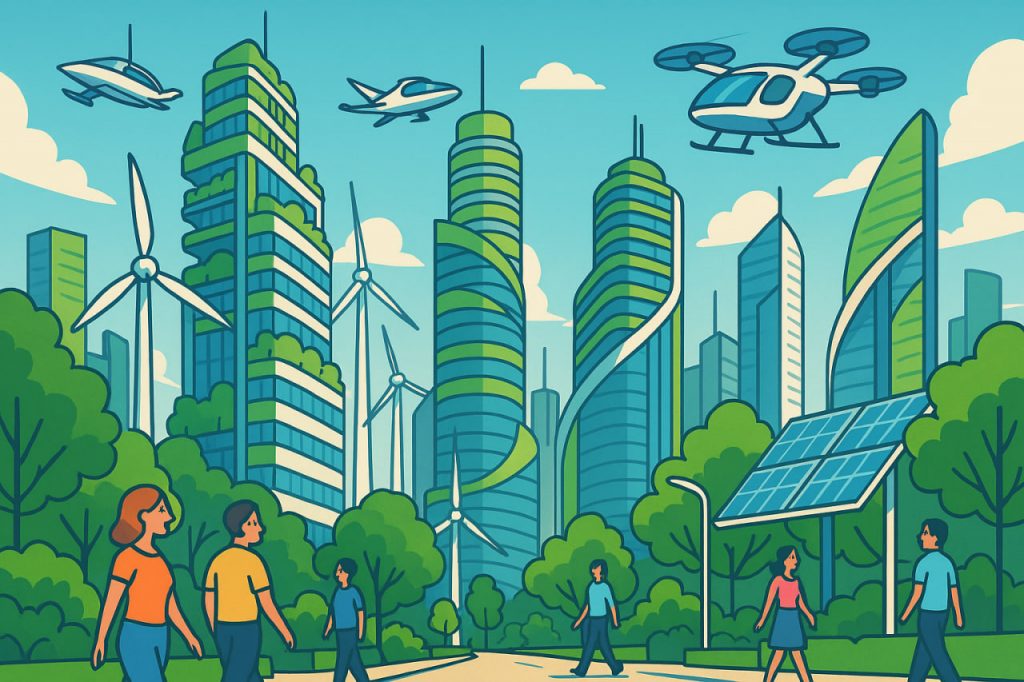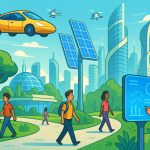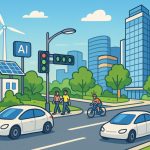The cities of the future will represent the ultimate fusion of technology, ecology, and human well-being. Unlike the crowded, polluted urban areas of today, tomorrow’s metropolises will be designed as self-sustaining ecosystems, where every building, vehicle, and system works together in harmony. These cities will harness renewable energy, advanced artificial intelligence, and circular economies to provide clean air, efficient transport, and comfortable living conditions for billions of people. Rather than fighting against nature, the urban world of the future will grow alongside it—green, adaptive, and alive.
Smart Infrastructure and Intelligent Design
In the cities of tomorrow, architecture will do far more than provide shelter—it will think, adapt, and interact. Buildings will be covered in solar panels, algae walls, and vertical gardens that generate energy, clean the air, and produce food. Smart materials will automatically regulate temperature and lighting, reducing energy consumption. Roads will be embedded with sensors to manage traffic and guide autonomous vehicles, while underground systems will recycle water and waste efficiently. In some designs, entire districts will move or reshape themselves depending on climate and population needs. Cities will no longer be static—they will breathe, respond, and evolve.
Clean Energy and Sustainability
The energy backbone of future cities will rely entirely on renewables—solar, wind, tidal, and geothermal. Power grids will be decentralized, with each building producing and storing its own electricity. Energy will flow dynamically between users, creating “energy-sharing” communities. Hydrogen and advanced battery systems will replace fossil fuels, drastically cutting carbon emissions. Waste will be transformed into raw material through circular economy principles, ensuring nothing is lost. Even transportation will run on clean energy—electric drones, hyperloops, and magnetic levitation trains will provide fast, zero-emission travel both within and between cities.
Mobility and Connectivity
Transportation in the city of the future will be silent, safe, and almost invisible. Self-driving electric vehicles will reduce congestion and accidents. Air taxis and delivery drones will move above ground, while underground hyper-speed tunnels will connect distant parts of megacities in minutes. Public transportation will blend seamlessly with personal mobility systems—scooters, pods, and walking exoskeletons—all coordinated by an AI that predicts and optimizes human movement. Instead of endless traffic jams, people will experience fluid, integrated mobility where time is never wasted.
Human-Centered Urban Life
Despite technological progress, the core of future cities will remain human. Urban design will prioritize mental health, community, and balance with nature. Parks, rooftop forests, and riverside promenades will dominate urban landscapes, while noise and pollution will be nearly eliminated. Public spaces will encourage interaction and creativity, turning cities into living classrooms and cultural hubs. Education, art, and science will be accessible everywhere through augmented reality, transforming daily life into a continuous learning experience. Inclusivity and accessibility will be at the heart of every design—ensuring that the city serves all, regardless of age or ability.
Vertical and Floating Cities
As populations grow and land becomes scarce, cities will expand vertically and even into the oceans. Vertical cities—towering megastructures containing homes, farms, offices, and parks—will rise into the sky, maximizing space while minimizing land use. Simultaneously, floating cities will emerge on water, built to adapt to rising sea levels and changing climates. These self-sustaining habitats will be powered by solar and wave energy, with desalination systems providing fresh water. Such innovations will redefine what “urban” means, breaking free from traditional geography altogether.
Artificial Intelligence and City Management
AI will act as the invisible brain of the city. It will monitor energy flow, traffic, air quality, and even social trends in real time, responding instantly to keep everything efficient and balanced. Predictive algorithms will detect problems before they occur—from water leaks to potential health hazards. Public safety systems will rely on drones, smart cameras, and environmental sensors. In this way, cities will become living organisms, self-regulating through the continuous exchange of information between humans, machines, and the environment.
Interesting Facts
- By 2050, over 70% of humanity will live in urban areas, demanding new sustainable designs.
- Some architects are already designing floating eco-cities to counteract rising sea levels.
- Singapore’s Marina Bay and Dubai’s The Line projects are real-world precursors to future city models.
- AI-controlled street lighting can reduce energy consumption by up to 60%.
- Vertical farming in cities could provide up to 80% of local food needs without long transport chains.
Glossary
- Smart City – An urban area that uses technology and data to improve efficiency, sustainability, and quality of life.
- Circular Economy – A model in which materials and resources are reused, recycled, and regenerated rather than discarded.
- Vertical City – A skyscraper-like structure containing entire communities, designed to save land and resources.
- Floating City – A self-sustaining settlement built on water, adapted to climate change.
- Renewable Energy – Energy derived from natural, replenishable sources like sunlight, wind, and water.
- Artificial Intelligence (AI) – Computer systems capable of learning and making decisions autonomously.
- Urban Mobility – Systems that enable efficient, safe, and sustainable movement within cities.
- Hyperloop – A high-speed transportation system using low-pressure tubes to move pods at near-supersonic speeds.
- Green Architecture – Building design focused on minimizing environmental impact.
- Decentralized Grid – A network in which energy is generated and shared locally instead of being controlled by a central power source.


